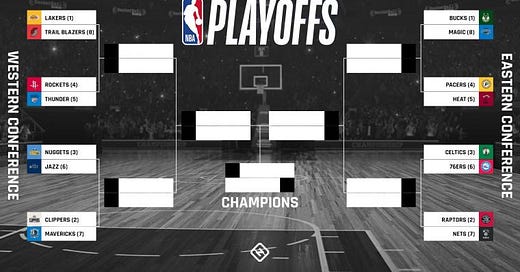The NBA Playoffs, now and before
The structure of professional basketball playoffs has changed several times over the past 77 years.
All-Star break is over and we’re in the final stretch of the 2023-24 NBA season. The NBA play-in tournament is now four years old and we’ll be looking at how the new format has changed the playoff picture and the shape of the game in general. We’ll also take a look back and see how the playoffs have changed in the past.
Tonight I watched my Lakers come back from down 21 to beat the Clippers on the back of an epic 4th quarter from Lebron. It was a much needed win and the Lakers (9th in the West) are fully in the thick of the play-in race. We sit just a half game above the Warriors and three games back from the 5th and 6th place Suns and Pelicans. The remaining stretch of the season is going to be intense for the Lakers (and quite a few other teams).
I think a lot of us were a little dubious about the play-in tournament when it first came along but I think it is safe to say that it has had a positive effect overall on the playoffs. I initially thought it sounded gimmicky and unnecessary but I have to admit that it has fostered more competition and, like overhauled draft odds, has reduced incentives for tanking.
In the current format, the first six teams get a guaranteed playoff berth while the 7-10 seeds have to duke it out in the play-in tournament. Last year the Lakers had to beat the Hawks to get into the playoffs and then made it to the Western conference finals. Miami was an even better Cinderella story, coming in through the play-in tournament and making it all the way to the finals.
The first basketball playoffs were played in 1947 between 6 teams. The BAA (Basketball Association of America) and NBL (National Basketball League) merged in 1949 to create the NBA but before that it was the BAA, which consisted of 11 teams. The format was a strange one where the two top teams (from a Western and Eastern division team) advanced directly to the semifinals but had to face each other immediately in a seven game series to make it to the finals. The other four teams played each other in a mini play-in style tournament (best of three) and could get to the finals by beating 2 teams.
After the first year, 4 of the 11 teams dropped out but the Baltimore Bullets were brought in from the A.B.L. (American Basketball Association) to bring the number of teams back up to 8 and four more joined to make it 12 for the 1948-49 season.
In 1949, the format was changed to have a champion from each division (East and West) who would then face each other in the finals and the number of total teams in the playoffs rose from 6 to 8. Two rounds (best of three) was followed by a 7 game finals series. For the 1949-50 season the league was organized into three divisions (East, West and Central) and in 1951 the Central Division Minneapolis Lakers became the first ‘NBA’ champions by defeating the Anderson Packers and then the Syracuse Nationals.
The league sputtered a bit in the fifties (from 1954-1966 the league only had 8-9 teams) when fewer remaining teams necessitated fewer playoff berths and in 1954 the NBA played a round robin format with three teams from each division playing each other before advancing. Over the years, the number of teams in the playoffs has changed quite a bit from 6 to 8..back to 6…back to 8 and then to 10, 12 and…finally in 1984 we get to 16 teams where it has remained since. The length of series has also generally increased from 3, to 5 to 7.
While the play-in tournament may still seem new, it’s interesting to note that change in the format of the playoffs is not. The new format could also be seen as a responsive sign of a healthy, growing league. With a couple more teams slated to be added soon, it will be interesting to watch and see if the playoff format continues to develop.
ANNEX
Here's a summary of how the format has evolved:
Early Years (1947-1950): Initially, the playoffs involved a three-stage tournament similar to the Stanley Cup playoffs of the 1930s, with the top two teams directly qualifying for one semifinal. The playoffs then featured best-of-three quarterfinals and semifinals, with the finals being best-of-seven.
1950s Changes: The format saw various modifications in the 1950s. By 1954-55, the second and third-place teams in each division faced off, and the winner played the division champion for a spot in the Finals. During the early 1950s, the number of playoff teams fluctuated, with as many as 12 teams participating in the 1950 playoffs due to a three-division setup.
Stabilization in the 1960s: From 1966-67, eight teams qualified for the playoffs, and this format persisted for several years, featuring a simple three-round knockout format.
Expansion in the 1970s-1980s: The playoff structure expanded alongside the league. By the mid-1970s, more teams were added to the playoffs, and by 1984, the playoffs included 16 teams, which is the format that largely continues today.
Recent Developments: In recent years, the playoffs have included 20 teams, with the bottom four in each conference playing in a play-in tournament to determine the final spots in the traditional 16-team bracket.



